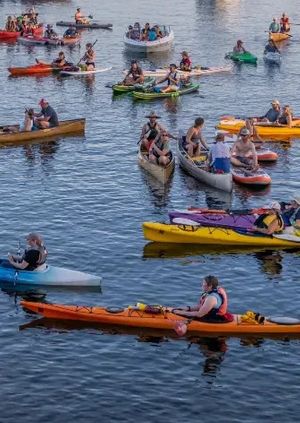
July 16 Concerts on the Pier Non-Motorized Watercraft Launching
at Glensheen
Tickets
Event Details
This year, Glensheen will offer onsite launching for non-motorized watercraft (ex. canoes, stand-up paddleboards (SUPs), or kayaks) in a limited capacity. Please register for a time slot to launch your non-motorized watercraft in one of the 15-minute time slots provided below (as availability allows). Glensheen is NOT a boat launch and we will not allow any motorized watercraft or boats to launch from our property. Please note that NO TRAILERS will be allowed in the Glensheen parking lot due to congestion issues. All non-motorized watercraft launched at Glensheen must be fastened directly to or contained within a vehicle.
Please see the attached map to find the loading zone that will be dedicated to drop-off and pick-up of non-motorized watercraft.
Glensheen Event Rules:
Prohibited Items:
- Outside food and alcohol (clear bottles with ONLY water are permitted)
- Pets or Emotional Support Animals (service animals are permitted)
- Weapons
- UAS (Drones)
- Use of illegal drugs or vape/tobacco/cannabis products
- Skateboards, scooters, bikes, and other wheeled motorized or non-motorized vehicles on the property (not allowed past entrance; parking area provided near entrance)
- All other items deemed prohibited at the discretion of event management
Permitted Items:
- Any type of bag (ex. purse, tote bag, diaper bag, medical bag)
- Portable chairs, blankets, and strollers/wagons
- Non-motorized watercraft (with Eventbrite registration and rules acknowledgment)
All bags and items are subject to screening at entry points by Glensheen staff prior to entering the property. All prohibited items must be disposed of or left in your vehicle before entering the property. Glensheen does not provide bag check/item storage at the gate. Please note that all unattended items will be relocated 30 minutes after the event end time.
By launching your non-motorized watercraft at Glensheen, you agree to abide by these rules for watercraft and our event:
Plan your trip with a map and tell someone your plans before you leave.
Make sure your route fits your experience and fitness levels. The average kayaking speed is 2-3 mph.
Travel with a companion or group, and know everyone's skill level. Discuss safety issues before leaving shore.
Seek instruction and practice paddling skills, including rescues, before paddling on Lake Superior. Be certain your vessel has adequate bow and stern flotation and that you have access to a pump for emptying a flooded vessel.
Anticipate changes in weather, wind, and waves by monitoring weather or marine VHF radio and using your awareness and common sense. The National Weather Service broadcasts a 24-hour updated marine forecast on KIG 64, weather band channel 1 on the maritime VHF frequency from Duluth. You can hear a version of this broadcast by calling 218-729-6697; press 4 for Lake Superior weather information. You also can use the VHF radio to call for emergency help.
Study shoreline features and review exit points before launching. Cliffs may create water turbulence that prevents you from going ashore.
Always wear a U.S. Coast Guard-approved personal flotation device. Each paddler is required to have one readily accessible.
Know the dangers of hypothermia and dress appropriately for cold water. (32 to 50 degrees Fahrenheit.) Cold water is a killer -- wearing a wet or dry suit is strongly recommended.
Carry with you: maps, compass, water, spray skirt, float for paddle, whistle, emergency flares, sunscreen, snacks, and a waterproof container with a first aid kit, matches and extra clothes.
Fog can make visibility zero. Bring a compass and know how to use it.
A bright white light must be displayed on each kayak or canoe after sunset to prevent a collision.
Purchase a license for your non-motorized watercraft if it's more than ten feet in length. If you're not from Minnesota, check your state's laws.
For further water safety information, please follow the guidance found on the DNR Lake Superior Safety website.


